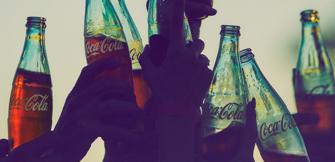
5 ways Coca‑Cola South Pacific is helping consumers enjoy less sugar
27-03-2017
Sugar. It’s an ingredient we read and hear a lot about. We know that many of our customers want to enjoy our products while at the same time consuming sugar in moderation.
That's why we are always working on offering that choice - starting with the introduction of Diet Coke back in 1983 right through to removing more than a quarter of the sugar from some of our Deep Spring range this year, and improving the availability of our mini packs so customers can drink our products in a size that's right for them.
In Australia, Coca‑Cola has been working hard to help the nation enjoy less sugar. Here's how:
1. There's a reduced or no-sugar, no-kilojoule option for almost every beverage
Want your favourite beverage, but don’t want the sugar? No problem.
Coca‑Cola South Pacific offers low kilojoule or no added sugar alternatives for 79% of more than 160 products across 24 brands.
One of The Coca‑Cola Company’s first no-sugar, low-kilojoule colas, Diet Cokewas introduced to Australians in 1983. Coke Zero followed 10 years ago and in April 2015, we launched lower sugar and kilojoule Coca‑Cola Life. More than 30% of the cola we sell is now Coca‑Cola Zero, Diet Coca‑Cola and Coca‑ColaLife.
By the end of 2014, all The Coca‑Cola Company’s top selling brands in Australia had a low-kilojoule alternative, including Coca‑Cola (Coca‑Cola Life, Diet Coca‑Cola and Coca‑Cola Zero), Sprite (Zero), Fanta (Zero), and Powerade (Zero).
2. We've removed sugar from some of our leading soft drinks
Since 2005, we’ve been working with a team of experts and nutritionists to refine recipes and remove sugar from many regular soft drinks.
Did you know? In 2016, we reduced sugar in Sprite by 14%, Raspberry Fanta by 19%, Fanta Grape and Lift Hard Hitting Lemon by 23%, and Deep Spring Orange Mango, Orange Passionfruit and Orange Lemon Lime by 26%.
What’s next? Between 2016 and 2017 we will have reduced the sugar content of 19 products.
3. We've been exploring different types of sweeteners
Cutting back on sugar doesn’t mean compromising on taste.
We have perfected ways of creating great-tasting drinks with less or no sugar, and the ways they do that are evolving over time. Stevia plant extract is one key ingredient we're using to reduce or replace the sugar in some drinks.
It’s a zero-kilojoule sweetener and comes from the leaves of the stevia plant. You’ll find it in beverages like Glaceau Vitaminwater Zero. It's the reason why we were able to launch Coca‑Cola Life with 45 per cent less sugar and kilojoules (than other full sugar colas), and give consumers a fourth cola to choose from.
4. We're providing more portion sizes than ever before
When it came to picking up a pack of your favourite beverage, we knew consumers wanted more choice. So we decided to make sure there was a pack size to suit a whole range of occasions.
The latest addition was a 250ml PET bottle, which hit shelves back in 2016. But we also provide refreshment in the form of a 200ml mini can, a standard 330ml can or a 1.25-litre bottle, designed for sharing with friends and family.
The 250ml can is available in 64% of convenience stores and 85% of grocery retailers. The 200ml multipacks were available in 94% of grocery channels.
We are seeing the results as smaller packs are now growing faster than larger packs in Australia. We continue to downsize our larger packs, including the 390ml PET to replace the larger 450ml PET in the majority of our stockists.
5. We're using clearer labels
We all want a quick and easy way to see what’s in our food and beverages.
Now, when you pick up a can or bottle you'll find that we list all the ingredients and nutritional information on the back – and on our website too – to help consumers make an informed choice.
We voluntarily introduced the % Daily Intake Guide label on all our products in 2007 which provides clear information on both the amount of kilojoules per serve and what this represents as a percentage of an adults total daily energy intake.
In 2014 we committed to adopting the Government’s voluntary Health Star Rating System (HSR) to assist consumers in making informed choices. The beverage category is part of the integrated HSR approach and as such needs to have a minimum display requirement of energy (kilojoules) only.
More recently we introduced nutrition information panels on our vending machines, reaching 75% by the end of 2015.
Launched in 2015, our online product comparison tool allows people to compare nutritional information and product ingredients across all of our beverages.
Read Time
What others are reading
More to enjoy